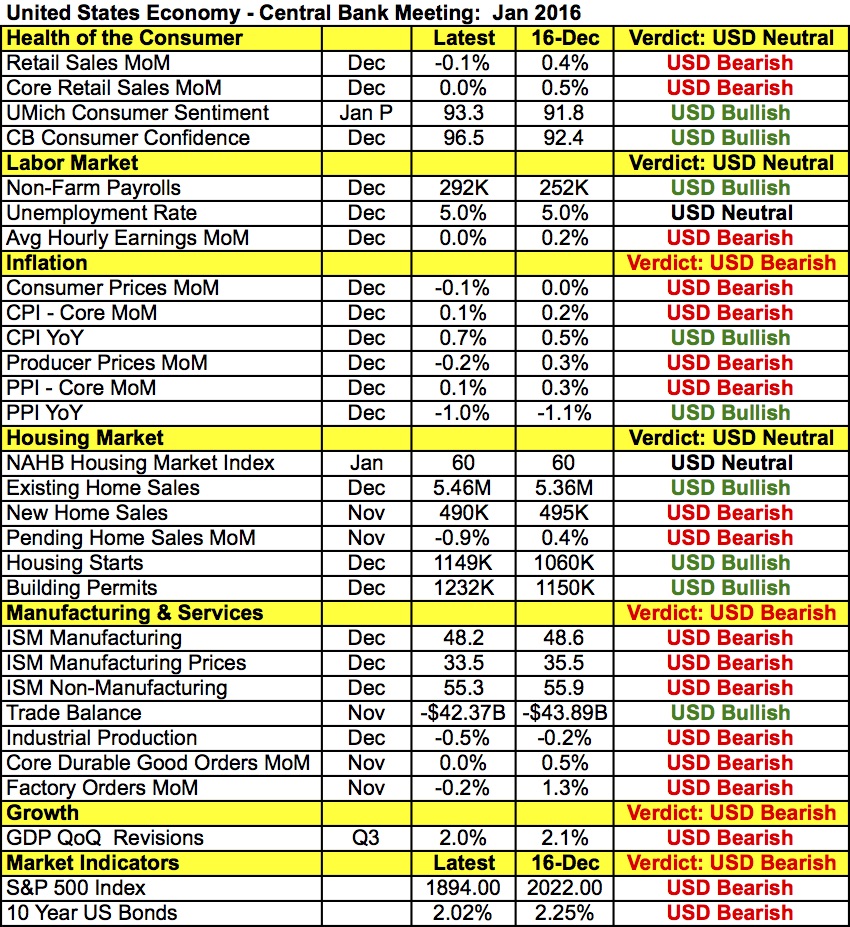By Kathy Lien, Managing Director of FX Strategy for BK Asset Management.
This is an important week for the U.S. dollar, but how the greenback performs will be determined by whether the Federal Reserve acknowledges the crazy swings in the financial markets since the start of the year. After the U.S. central bank hiked interest rates in December, the S&P 500 dropped 7%, oil prices fell 12% and the VIX is up 28%. Policymakers around the world raised concerns about this volatility with ECB President Draghi being the most vocal. However having only raised interest rates last month, U.S. policymakers may feel that it is premature to adjust their forward guidance, especially since they didn’t commit to a specific timetable for additional tightening. Adopting a less hawkish bias and then changing it later could cause more disruption to the financial markets than maintaining a steady stance and the FOMC statement virtually unchanged. There are 2 nonfarm payroll reports and 7 weeks between the January and March meetings, so there’s plenty of time for the Fed to see how the market and economy performs before shifting their forward guidance. If they wait until March, Janet Yellen could smooth the reaction through her press conference.
We don’t expect this week’s FOMC meeting to be very exciting. There’s no doubt that the Federal Reserve will keep interest rates unchanged and there’s no press conference to spark additional volatility. While we believe the Fed should acknowledge the decline in inflation, slowdown in emerging markets, damage created by a strong dollar and big moves in equities and commodities, there’s enough improvement in the U.S. economy since the last meeting for policymakers to reserve judgment until March. We know that the central bank’s primary focus is jobs and as shown in the table below, nonfarm payrolls exceeded expectations in December, the unemployment rate held steady and consumer confidence improved. A larger part of the housing market saw increased activity and the trade deficit narrowed. Although consumer and producer prices fell month over month, on an annualized basis price pressures increased. Of course there has also been plenty of weakness in retail sales, average hourly earnings, manufacturing- and service-sector activity along with GDP, so Fed officials won’t need to reach far for excuses to delay tightening. If fresh concerns are raised in this week’s FOMC statement, USD/JPY will hit 117. But if the statement remains unchanged, we could see the pair spike to 119.50 at which point sellers should sweep in.

The euro’s resilience has been quite impressive considering the growing possibility of more ECB stimulus. EUR/USD traded higher Monday despite softer than expected economic data and cautious comments from Mario Draghi. Business confidence is souring according to the latest German IFO report, which dropped to its lowest level in 11 months. Despite the decline in oil prices and ECB easing last month, German businesses are nervous about market volatility and the slowdown in China. According to IFO President Hans-Werner Sinn, “German business leaders are looking to the new year with some anxiety,” which furthers the case for additional central-bank support. Mario Draghi spoke in Germany Monday and while he sounded more relaxed compared to last week when he warned of the possibility of more action, he repeated that the economic outlook for 2016 is uncertain. But there are a few explanations for the euro’s resilience – investors are focused on the U.S. dollar, European yields fell less than U.S. yields on Monday and speculators are very short euros, which means they could be waiting for the FOMC decision before adding to their positions.
The big moves in oil continue to affect currencies with the Canadian dollar experiencing steep losses. Oil prices dropped more than 7% after the Chairman of Saudi Aramco said that despite lower oil prices, his company would maintain their investments in energy projects. This indicates that despite diminishing returns, companies in the world’s largest exporting nation are not wavering in their battle for market share. The decline in crude has many countries calling for an emergency OPEC meeting but so far it seems that many market leaders are resisting. While we are still looking for USD/CAD to fall to 1.4000, we believe we’ll have the opportunity to sell it again above 1.43.
Meanwhile we are looking for further losses in the British pound following Monday morning’s CBI report. According to the Confederation of British Industry, manufacturing orders fell sharply in January. While this is not a widely followed release, it should not be ignored because we have found that it has a strong correlation with the broader PMI manufacturing report. Export orders fell at a sharp pace in January because “uncertainty around the prospects for global growth, uncompetitive energy costs and the strength of the pound have all played their part in U.K. manufacturers finding conditions tough when trying to sell overseas,” according to the CBI director. GDP is the only piece of market-moving U.K. data on this week’s calendar and recent reports including CBI point to a slowdown in growth. As such, we expect sterling to make another run for its 5-years lows.
Finally the Australian and New Zealand dollars were also pressured by lower commodity prices and softer data. AUD fell more than NZD during the North American session because according to NAB, business confidence deteriorated in December. At the start of Monday night’s Asian session, however, NZD began to catch up after New Zealand reported weaker service-sector activity.
